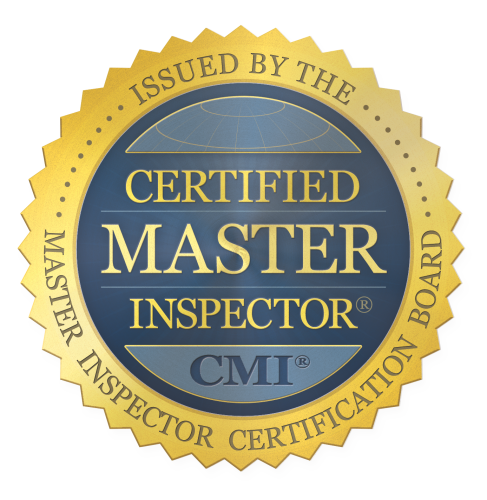Radon Inspections
How Radon Inspections Work 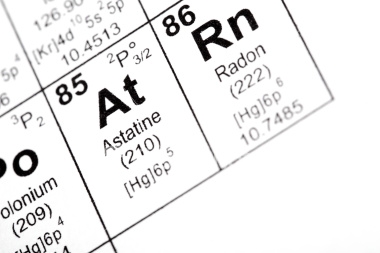
What is Radon?
Radon is a naturally occurring radioactive soil gas. The gas is emitted by the deterioration of uranium present in the soil. High radon levels can be found in areas where there are high concentrations of rock such as granite and slate and shale which can contain small uranium deposits. When the foundation of a house is scooped out, a small uranium deposit can be cut into or otherwise disturbed. The subsequent gas emissions from that disturbance can seep into a house through small cracks and gaps under and in the foundation walls of the house.
An article in Consumer Reports (July, 1995, page 464) claimed that no other environmental hazard causes as many deaths. It is unknown if actual lung-cancer deaths can accurately be tied to radon however. Radon-caused deaths per year are estimates. For example, the 1998 BEIR VI report of the National Academy of Sciences estimated that as many as 15,000 deaths from radon occur in the United States each year. Some risk estimates have been based upon studies of miners who no doubt breathe heavily in order to perform their labor, breathing in dusty air as they do. Studying them, therefore, may overestimate the risk to sedentary occupants of houses. Nevertheless, a Swedish study found that lung cancer is 80% more likely for occupants of homes with higher radon levels (at least 10.8 pCi/l - see below) and as much as 30 times more likely if those residents are smokers. The indoor half life of radon gas is 3.8 days.
How Likely is Radon Present in My Home?
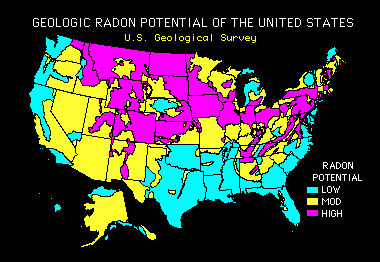
Radon is found in nearly all homes, particularly in the lowest floor level. Concentrations can be nearly as bad in older, drafty homes as they are in newer, "tighter" homes. Rising hot air that departs through cracks can creat a "chimney effect" in cold weather that sucks the radon-bearing soil gas into the house through the foundation. Recent data show that about 6% of all homes studied contained radon levels that exceeded the Environmental Protection Agency's "action level" of 4 picoCuries of radiation per liter of air (pCi/l). "Pico" means one-trillionth and a Curie is a unit of radiation. Outdoor air contains only about 1/10th as much radon - about 0.4 pCi/l. The average radon amount in homes nationwide is 1.3 pCi/l. At present, it is believed that a lifetime exposure of 4.0 pCi/l would result in about 2 cancer deaths per 1,000. But this is an estimate! For smokers with the same exposure, the radon risk jumps to about 29 per 1,000, according to the same Consumer Reports article sited above. There are maps available online from states and counties showing relative radon risks, but the only way to know if your house has radon is to perform a radon test. There can be one house alone in a neighborhood of high concentration that tests without radon, and oppositely only one house in a low-risk neighborhood that has it. It is impossible to know without a proper test. High radon levels have been detected and reported all over Northern Virginia, so testing is regularly done there.
Some professional societies have recommended that EPA limits in houses be reduced to half of the current actionable level of 4 pCi/l, or 2 pci/l! Conversely, Canada's action level is 20 to 27 pCi/l and European standards can vary from 8 to 27 pCi/l. The government in many countries pays for remediation and action levels may be set according to what the government thinks it can afford. So "actionable" radon levels all need to be taken with a grain of salt.
Home Inspection Testing Problems
No short-term radon test is considered to be totally accurate, but it is the best that can be done during the short time frame of a pre-purchase contract period. Many factors can influence the outcome of short-term tests. Are doors or windows opened by the homeowners a lot during the testing period? Did they turn on bath exhaust fans (which can suck radon into the house)? Did they cheat by creating conditions which altered the test?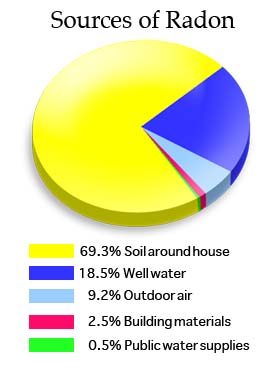 Running ceiling fans can reduce radon in a room by 50%. Cheating is commonly detected. Sometimes re-testing is done with dramatically different results.
Running ceiling fans can reduce radon in a room by 50%. Cheating is commonly detected. Sometimes re-testing is done with dramatically different results.
For these and many other reasons, experts claim that any short-term test is unreliable. There are many factors that can skew a test -- high winds or a change in wind direction, a low pressure front, heavy rains, frozen soil. But even a quick test taken by home purchasers may be worthwhile if it gives a high reading that triggers a remediation system to be put into the home.
Radon Testing Procedures
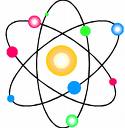 The U.S. EPA Indoor Environments Division has determined that a basic home radon inspection can be done by homeowners prior to a test. There is a simple check list. Home buyers can use this list to determine if they want to order a radon test. The checklist can be downloaded from the EPA by clicking here. Look for the Radon Mitigation System Inspection Checklist.PDF toward the end.
The U.S. EPA Indoor Environments Division has determined that a basic home radon inspection can be done by homeowners prior to a test. There is a simple check list. Home buyers can use this list to determine if they want to order a radon test. The checklist can be downloaded from the EPA by clicking here. Look for the Radon Mitigation System Inspection Checklist.PDF toward the end.
Jay Markanich Real Estate Inspections performs radon testing with USEPA-approved E-PERM devices. These are also known as an Electret Ion Chamber (EIC), and are passive, integrating, ionization monitors consisting of a very stable electret mounted inside a small chamber made of electrically conducting plastic. For over fifteen years, E-PERM devices have been recognized in the U.S. and around the world for their highly accurate, very durable, radon detection abilities. This technology consistently outperformed all other radon testing methods in the USEPA Radon Measurement Proficiency Program.
The electret is a charged Teflon disk, and serves as both the source for ion collection and as the integrating ion sensor. Negative ions produced inside the chamber are collected on the positively charged electret, causing a reduction of its surface charge. The electret charge is measured before and after the measurement period. This data is input into an appropriate formula, and radon activity is determined. E-PERM devices are known as "true integrators" because they are constantly collecting and "registering" the ions generated by the radon decaying inside the chamber. Jay Markanich can print the results right at the home inspection and the report is given to the buyer along with the home inspection report.
References and Help
EPA has booklets - call your local EPA office. For a thorough discussion get Radon: A Homeowner's Guide to Detection and Control, by B. L. Cohen. (Consumer Reports Books, 9180 LeSaint Drive, Fairfield OH 45014-5452)
Not every inspector uses E-PERM technology. Jay Markanich does. And from his office in Bristow he is doing tests all over Northern Virginia. Call today for scheduling and pricing information. INSIST on Jay Markanich!
